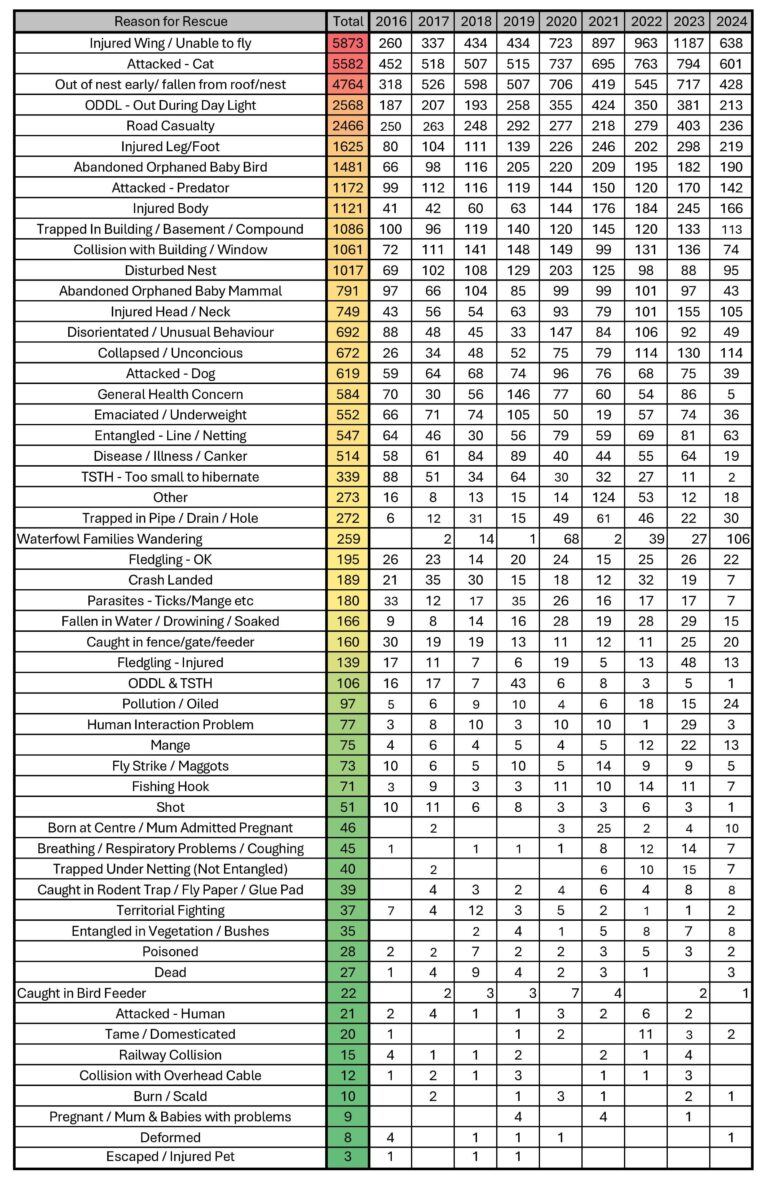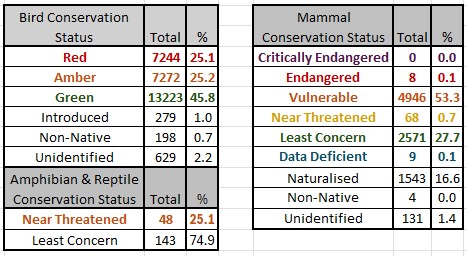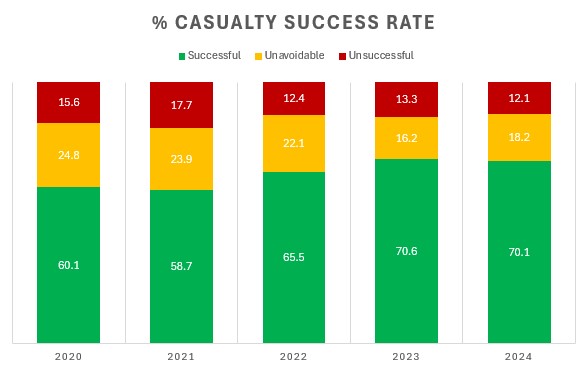Traditionally, the period from April to the end of September marks our busiest season. Weather significantly influences our peak times. In some years, a prolonged cold spell through March and April can delay the onset of the busy season, while a mild autumn can extend it.

2024 was our busiest year to date, with a considerable increase throughout the year.
Every year the number of casualties we deal with generally increases. The only exception has been in 2020 during the Covid lockdowns which occurring at the height of the busy season. People were working from home and and if their cat or dog caught a wild animal or bird they were there to rescue it and save it, where as normally they would come home from work and either not know their pet had caught a wild creature or the creature was found dead. Not surprisingly the following year the total decreased.




The above table is not completely accurate as this is based on the initial call out assessment, which can change. However, categories like Cat, Dog or predator attacks are only used where the someone has actually witnessed that animal attacking the casualty, otherwise the injuries are recorded as one of the injury categories where the cause is not known.
Human attacks, cat attacks, dog attacks, road casualties are suspected to be much higher than recorded here as they are often not witnessed but the injuries and location are consistent with those type of incidents.
A number of cases could be classed as falling into more than one of the categories above, but the primarily reason why we are being asked to attend a rescue will be recorded only. For example we deal with far more orphan young birds and mammals than listed above but some are reported as being a cat attack as the primary reason for rescue. A collapsed mange fox would be recorded as collapsed not mange. Or a fox trapped in a basement or compound wound be recorded as that rather as mange even if it had mange.
Not surprisingly the most common species which we deal with are those who are most commonly coming into conflict with humans.



Above is a table listing the key towns and villages where East Sussex WRAS has received casualties over the last few years.
Eastbourne has always been the heart of our area and we are best known in that town than anywhere else hence the highest number of calls to that area. We also find that people often refer to themselves as being in Eastbourne when in fact that are often in a suburb like Willingdon, Langney or Sovereign Harbour.
Calls about casualties in the very north of East Sussex are generally passed to Folly Wildlife Rescue, casualties in the far east of East Sussex are passed to the RSPCA Mallydams Wood Wildlife Hospital.
A small organisation has been operating in the Bexhill & Hastings area for the last few years but are now winding down meaning there is now an increase in the number of calls we are receiving for that area. Due to Rogers Wildlife Rescue cutting back due to Rogers age, a new organisation called Brighton & Hove Wildlife Advice & Rescue Service has set up. They don't have any hospital facilities and work with surrounding organisations like WRAS who help to take in as many casualties as possible, therefore seeing an increase in the number of casualties we are admitting from that area.

This information is based on the town and the key council area which covers that town. In locations where a town is covered by more than one council like Saltdean being covered by both Brighton & Hoce City Council and Lewes District Council, the data will lead to a slight imbalance in the results.

Approximately 63% of all casualties we handle are attended to on-site, either by our Collection Volunteers, who provide a taxi service, or by our rescuers in veterinary ambulances. The Covid pandemic led to a surge in collections due to restrictions, and in 2022, WRAS had to operate under constraints because of Avian Influenza, which limited the number of on-site attendances. There is an increasing trend of casualties being delivered by the public, volunteers from Brighton & Hove WARS and being collected from veterinary centres.


